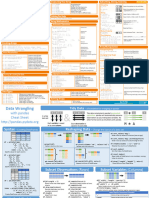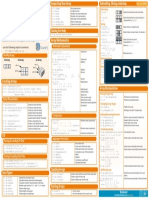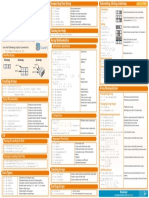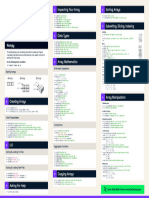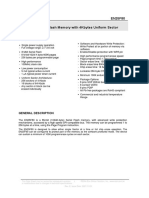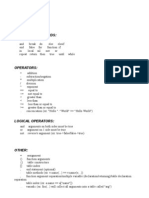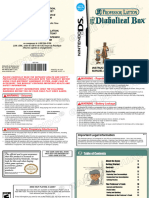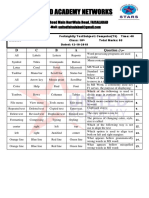Python For Data Science Cheat Sheet Inspecting Your Array Subse!
ing, Slicing, Indexing Also see Lists
>>> a.shape Array dimensions Subse!ing
NumPy Basics >>>
>>>
len(a)
b.ndim
Length of array
Number of array dimensions
>>> a[2]
3
1 2 3 Select the element at the 2nd index
Learn Python for Data Science Interactively at www.DataCamp.com >>> e.size Number of array elements >>> b[1,2] 1.5 2 3 Select the element at row 1 column 2
>>> b.dtype Data type of array elements 6.0 4 5 6 (equivalent to b[1][2])
>>> b.dtype.name Name of data type
>>> b.astype(int) Convert an array to a different type Slicing
NumPy >>> a[0:2]
array([1, 2])
1 2 3 Select items at index 0 and 1
2
The NumPy library is the core library for scientific computing in Asking For Help >>> b[0:2,1] 1.5 2 3 Select items at rows 0 and 1 in column 1
>>> np.info(np.ndarray.dtype) array([ 2., 5.]) 4 5 6
Python. It provides a high-performance multidimensional array
Array Mathematics
1.5 2 3
object, and tools for working with these arrays. >>> b[:1] Select all items at row 0
array([[1.5, 2., 3.]]) 4 5 6 (equivalent to b[0:1, :])
Arithmetic Operations >>> c[1,...] Same as [1,:,:]
Use the following import convention: array([[[ 3., 2., 1.],
>>> import numpy as np [ 4., 5., 6.]]])
>>> g = a - b Subtraction
array([[-0.5, 0. , 0. ], >>> a[ : :-1] Reversed array a
NumPy Arrays [-3. , -3. , -3. ]])
array([3, 2, 1])
Boolean Indexing
1D array 2D array 3D array >>> np.subtract(a,b) Subtraction
>>> a[a<2] Select elements from a less than 2
>>> b + a Addition 1 2 3
array([1])
axis 1 axis 2 array([[ 2.5, 4. , 6. ],
1 2 3 axis 1 [ 5. , 7. , 9. ]]) Fancy Indexing
1.5 2 3 >>> np.add(b,a) Addition >>> b[[1, 0, 1, 0],[0, 1, 2, 0]] Select elements (1,0),(0,1),(1,2) and (0,0)
axis 0 axis 0 array([ 4. , 2. , 6. , 1.5])
4 5 6 >>> a / b Division
array([[ 0.66666667, 1. , 1. ], >>> b[[1, 0, 1, 0]][:,[0,1,2,0]] Select a subset of the matrix’s rows
[ 0.25 , 0.4 , 0.5 ]]) array([[ 4. ,5. , 6. , 4. ], and columns
>>> np.divide(a,b) Division [ 1.5, 2. , 3. , 1.5],
Creating Arrays >>> a * b
array([[ 1.5, 4. , 9. ],
Multiplication
[ 4. , 5.
[ 1.5, 2.
,
,
6.
3.
,
,
4. ],
1.5]])
>>> a = np.array([1,2,3]) [ 4. , 10. , 18. ]])
>>> b = np.array([(1.5,2,3), (4,5,6)], dtype = float) >>> np.multiply(a,b) Multiplication Array Manipulation
>>> c = np.array([[(1.5,2,3), (4,5,6)], [(3,2,1), (4,5,6)]], >>> np.exp(b) Exponentiation
dtype = float) >>> np.sqrt(b) Square root Transposing Array
>>> np.sin(a) Print sines of an array >>> i = np.transpose(b) Permute array dimensions
Initial Placeholders >>> np.cos(b) Element-wise cosine >>> i.T Permute array dimensions
>>> np.log(a) Element-wise natural logarithm
>>> np.zeros((3,4)) Create an array of zeros >>> e.dot(f) Dot product
Changing Array Shape
>>> np.ones((2,3,4),dtype=np.int16) Create an array of ones array([[ 7., 7.], >>> b.ravel() Fla"en the array
>>> d = np.arange(10,25,5) Create an array of evenly [ 7., 7.]]) >>> g.reshape(3,-2) Reshape, but don’t change data
spaced values (step value)
>>> np.linspace(0,2,9) Create an array of evenly Comparison Adding/Removing Elements
spaced values (number of samples) >>> h.resize((2,6)) Return a new array with shape (2,6)
>>> e = np.full((2,2),7) Create a constant array >>> a == b Element-wise comparison >>> np.append(h,g) Append items to an array
>>> f = np.eye(2) Create a 2X2 identity matrix array([[False, True, True], >>> np.insert(a, 1, 5) Insert items in an array
>>> np.random.random((2,2)) Create an array with random values [False, False, False]], dtype=bool) >>> np.delete(a,[1]) Delete items from an array
>>> np.empty((3,2)) Create an empty array >>> a < 2 Element-wise comparison Combining Arrays
array([True, False, False], dtype=bool)
>>> np.array_equal(a, b) Array-wise comparison >>> np.concatenate((a,d),axis=0) Concatenate arrays
I/O array([ 1, 2, 3, 10, 15, 20])
Stack arrays vertically (row-wise)
Aggregate Functions >>> np.vstack((a,b))
Saving & Loading On Disk array([[ 1. ,
[ 1.5,
2. ,
2. ,
3. ],
3. ],
>>> a.sum() Array-wise sum [ 4. , 5. , 6. ]])
>>> np.save('my_array', a) >>> a.min() Array-wise minimum value >>> np.r_[e,f] Stack arrays vertically (row-wise)
>>> np.savez('array.npz', a, b) >>> b.max(axis=0) Maximum value of an array row >>> np.hstack((e,f)) Stack arrays horizontally (column-wise)
>>> np.load('my_array.npy') >>> b.cumsum(axis=1) Cumulative sum of the elements array([[ 7., 7., 1., 0.],
>>> a.mean() Mean [ 7., 7., 0., 1.]])
Saving & Loading Text Files >>> b.median() Median >>> np.column_stack((a,d)) Create stacked column-wise arrays
>>> np.loadtxt("myfile.txt") >>> a.corrcoef() Correlation coefficient array([[ 1, 10],
>>> np.std(b) Standard deviation [ 2, 15],
>>> np.genfromtxt("my_file.csv", delimiter=',') [ 3, 20]])
>>> np.savetxt("myarray.txt", a, delimiter=" ") >>> np.c_[a,d] Create stacked column-wise arrays
Copying Arrays Spli!ing Arrays
Data Types >>> h = a.view() Create a view of the array with the same data >>> np.hsplit(a,3) Split the array horizontally at the 3rd
>>> np.copy(a) Create a copy of the array [array([1]),array([2]),array([3])] index
>>> np.int64 Signed 64-bit integer types >>> np.vsplit(c,2) Split the array vertically at the 2nd index
>>> np.float32 Standard double-precision floating point >>> h = a.copy() Create a deep copy of the array [array([[[ 1.5, 2. , 1. ],
>>> np.complex Complex numbers represented by 128 floats [ 4. , 5. , 6. ]]]),
array([[[ 3., 2., 3.],
>>>
>>>
np.bool
np.object
Boolean type storing TRUE and FALSE values
Python object type Sorting Arrays [ 4., 5., 6.]]])]
>>> np.string_ Fixed-length string type >>> a.sort() Sort an array
>>> np.unicode_ Fixed-length unicode type >>> c.sort(axis=0) Sort the elements of an array's axis DataCamp
Learn Python for Data Science Interactively
